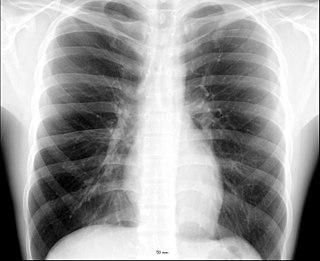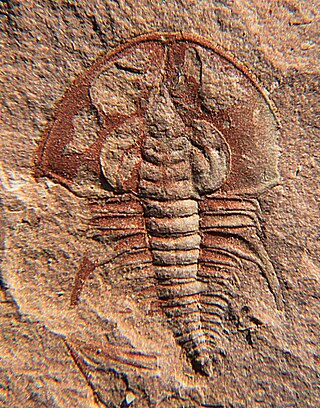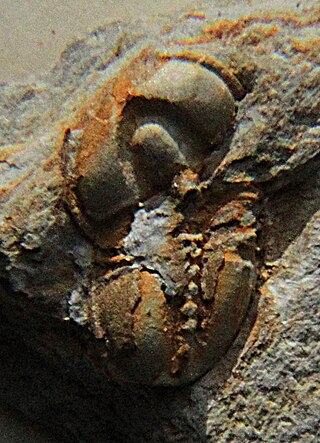
Agnostida are an order of extinct arthropods which have classically been seen as a group of highly modified trilobites, though some recent research has doubted this placement. Regardless, they appear to be close relatives as part of the Artiopoda. They are present in the Lower Cambrian fossil record along with trilobites from the Redlichiida, Corynexochida, and Ptychopariida orders, and were highly diverse throughout the Cambrian. Agnostidan diversity severely declined during the Cambrian-Ordovician transition, and the last agnostidans went extinct in the Late Ordovician.

Trilobites are extinct marine arthropods that form the class Trilobita. Trilobites form one of the earliest known groups of arthropods. The first appearance of trilobites in the fossil record defines the base of the Atdabanian stage of the Early Cambrian period and they flourished throughout the lower Paleozoic before slipping into a long decline, when, during the Devonian, all trilobite orders except the Proetida died out. The last trilobites disappeared in the mass extinction at the end of the Permian about 251.9 million years ago. Trilobites were among the most successful of all early animals, existing in oceans for almost 270 million years, with over 22,000 species having been described.

Redlichiida is an order of trilobites, a group of extinct marine arthropods. Species assigned to the order Redlichiida are among the first trilobites to appear in the fossil record, about halfway during the Lower Cambrian. Due to the difficulty to relate sediments in different areas, there remains some discussion, but among the earliest are Fallotaspis, and Lemdadella, both belonging to this order. The first representatives of the orders Corynexochida and Ptychopariida also appear very early on and may prove to be even earlier than any redlichiid species. In terms of anatomical comparison, the earliest redlichiid species are probably ancestral to all other trilobite orders and share many primitive characters. The last redlichiid trilobites died out before the end of the Middle Cambrian.

The thorax or chest is a part of the anatomy of mammals and other tetrapod animals located between the neck and the abdomen. In insects, crustaceans, and the extinct trilobites, the thorax is one of the three main divisions of the creature's body, each of which is in turn composed of multiple segments.

Harpetida is one of the eleven orders of the extinct arthropod class Trilobita. The first harpetid trilobites appear in the Upper Cambrian, and the last species die out at the end of the Devonian period.

Phacopida ("lens-face") is an order of trilobites that lived from the Late Cambrian to the Late Devonian. It is made up of a morphologically diverse assemblage of taxa in three related suborders.

Ptychopariida is a large, heterogeneous order of trilobite containing some of the most primitive species known. The earliest species occurred in the second half of the Lower Cambrian, and the last species did not survive the Ordovician–Silurian extinction event.

Proetida is an order of trilobite that lived from the Ordovician to the Permian. It was the last surviving order of trilobite, dying out in the Permian-Triassic extinction event.

Olenellina is a suborder of the order Redlichiida of trilobites that occurs about halfway during the Lower Cambrian, at the start of the stage called the Atdabanian. The earliest trilobites in the fossil record are arguably Olenellina, although the earliest Redlichiina,Ptychopariida, and Eodiscina follow quickly. The suborder died out when the Lower Cambrian passed into the Middle Cambrian, at the end of the stage called Toyonian. A feature uniting the Olenellina is the lack of rupture lines in the headshield, which in other trilobites assist the periodic moulting, associated with arthropod growth. Some derived trilobites have lost facial sutures again, but all of these are blind, while all Olenellina have eyes.

Elrathia is a genus of trilobite belonging to Ptychopariacea known from the mid-Cambrian of Laurentia. E. kingii is one of the most common trilobite fossils in the USA locally found in extremely high concentrations within the Wheeler Formation in the U.S. state of Utah. E. kingii has been considered the most recognizable trilobite. Commercial quarries extract E. kingii in prolific numbers, with just one commercial collector estimating 1.5 million specimens extracted in a 20-year career. 1950 specimens of Elrathia are known from the Greater Phyllopod bed, where they comprise 3.7% of the community.
"...trilobite occupied the exaerobic zone, at the boundary of anoxic and dysoxic bottom waters. E. kingii consistently occur in settings below the oxygen levels required by other contemporaneous epifaunal and infaunal benthic biota and may have derived energy from a food web that existed independently of phototrophic primary productivity. Although other fossil organisms are known to have preferred such environments, E. kingii is the earliest-known inhabitant of them, extending the documented range of the exaerobic ecological strategy into the Cambrian Period."

Aulacopleura is a genus of proetid trilobite that lived from the Middle Ordovician to the Middle Devonian. Some authors may classify this group as subgenus Otarion (Aulacopleura). The cephalon is semicircular or semielliptical, with border and preglabellar field. The glabella is short, with or without defined eye ridges connecting it with eyes of variable size. Spines at the rear outer corners of the cephalon are present, typically reaching back to the 2nd to 4th thorax segment. The 'palate' is not connected to the dorsal shield of the cephalon. The cephalon is pitted, or has small tubercles. The thorax has up to 22 segments. The pleural ends are usually rounded. The pygidium is small (micropygous), with an even margin. A. koninckii had a modern type of compound eye.

Ptychopariidae is a family of trilobites, containing the following genera:

Ptychoparia is a genus of ptychopariid trilobites, and is the type genus of the family Ptychopariidae, and the order Ptychopariida.

Eodiscina is trilobite suborder. The Eodiscina first developed near the end of the Lower Cambrian period and became extinct at the end of the Middle Cambrian. Species are tiny to small, and have a thorax of two or three segments. Eodiscina includes six families classified under one superfamily, Eodiscoidea.
The Burlingiidae constitute a family of trilobites of uncertain affinity, that lived during the Middle to lowest Upper Cambrian. Burlingiids have a cosmopolitan distribution, can be found in deposits that originate from outside the continental shelves, and may have been planktonic. They are characterized by their oval shape, small size, proparian sutures, and non-functional articulations of the thorax. Uniquely the anterior borders of the pleura are raised, and there are between 8 and 15 thorax segments. Burlingiid trilobites have been found in Norway, Sweden, Northern Siberia, Eastern and South-eastern China, Australia (Tasmania), India (Himalayas) and the United Kingdom.

Librostoma is a subclass of trilobites defined by having a natant hypostome, which is a hypostome that is free from the anterior doublure and aligned with the anterior of the glabella, this is unlike a conterminant hypostome, which is attached to the exoskeleton.

Olenina is an extinct suborder of the trilobite order Ptychopariida.

Ptychoparioidea is a superfamily of the Ptychopariida order of trilobites.
Diceratocephalidae is an family of trilobites belonging to the order Ptychopariida.
Ellipsocephaloidea is a superfamily of trilobites that lived during the Cambrian period. It was first described by Lin in 1990.














